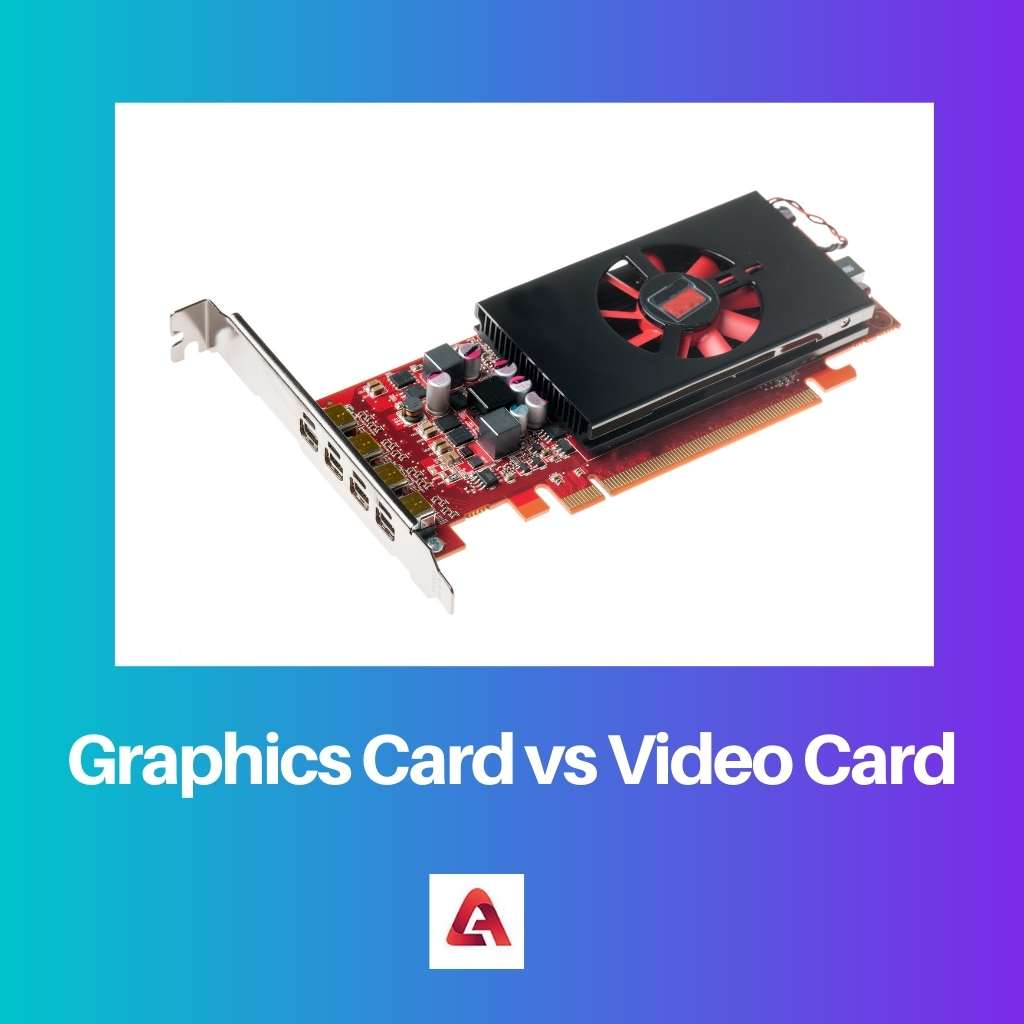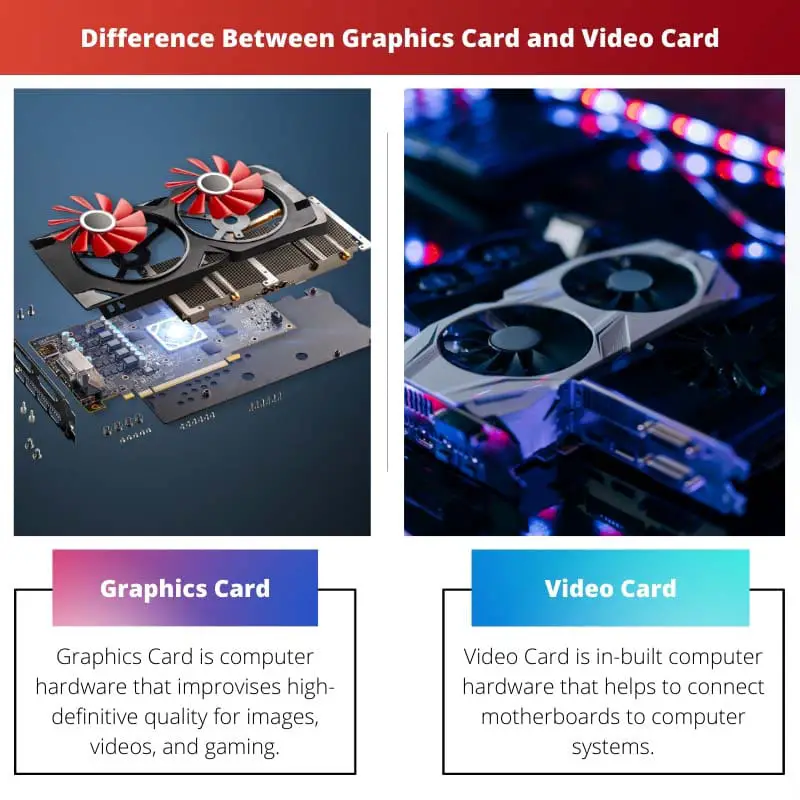Visual is the first thing we see on a computer system as it entices our eyes into the display.
Accordingly, graphic cards and Video cards are different in technical terms, as Graphic cards are the hardware that comes separately for better gaming performance. Still, video cards are in-built hardware for computer system performances.
Key Takeaways
- Graphics cards process and render images for display, while video cards focus on playback and editing.
- Modern graphics cards include video card functions, making the distinction between the two less relevant.
- Video cards may have specialized video encoding and decoding features not found in graphics cards.
Graphics Card vs Video Card
Graphics cards are designed to handle complex mathematical calculations and process instructions from the CPU to create the final image on the monitor. The video card is essential for any computer that requires high-quality graphics performance, such as gaming, video editing, and 3D modelling.

Graphics Card is also popularly referred to as a gaming card, as it generates high-quality output images on the display devices, thereby underscoring the integrated graphics of the content.
Overall, its main role is to improve the graphical representations on the computer. Graphics Card is a printed circuit board with a processor and RAM.
Meanwhile, a Video Card is a display controller implanted in the computer’s motherboard.
It comprises various electronic circuits, including GPU, visual processor, VGA card, digital visual interface(DVI), and Video memory. Due to its controllability, it assists greatly while editing videos and other multimedia projects on the devices.
Comparison Table
| Parameters of Comparison | Graphics Card | Video Card |
|---|---|---|
| Meaning | Graphics Card is computer hardware that improvises high-definitive quality for images, videos, and gaming. | Video Card is in-built computer hardware that helps to connect motherboards to computer systems. |
| Supported | Video Card is essential for the computer’s display setting and comes with the computer/PC. | Video Cards are used for editing, controlling speed, resolution, colours, or display settings of PCs. |
| Types | Integrated, PCI, AGP, and PCI- Express. | VRAM, WRAM, SDRAM, SGRAM, DDR-SDRAM, G-DDR3-SDRAM, G-DDR2-SDRAM, G-DDR5-SDRAM, and G-DDR4-SDRAM. |
| RAM | Graphic Card owns RAM, which is installed for better performance | Video Card doesn’t own RAM system |
| Purpose | Graphic Cards are used for gaming purposes and also render 3D experiences. | Video Cards are used for editing, controlling speed, resolution, colors, or display settings of PCs. |
What is Graphics Card?
A Graphics card is primarily encompassed by a GPU (Graphics Processing Unit) card and RAM, which is used to instantly process graphical data on the device’s screen.
Moreover, it plays a huge part in gaming PCs and devices, as it improvises high-definitive quality for images and videos during gaming.
Besides, Graphic Card replaces the devices’ RAM and GPU, so it does not come with the computer’s installation but as a printed circuit board alongside other components.
Meanwhile, the other components include a heat sink, firmware, Video memory, D-Sub, DVI(Digital Visual Interface), HDMI (High-Definition Multimedia Interface), Display port, and USBs.
IBM is the first company to invent and manufacture the first Graphics Card. It was initially invented as a plug-in adapter in CRT devices in the 1990s.
Since its invention, Graphics Card has been predominantly manufactured by two brands; Nvidia and AMD.
Graphics Card is an exemplary processor that could even outstand the performance of a computer’s GPU and CPU regarding video, images, and graphics production applications.
Its fundamental role is to display good graphical content on the devices’ screen efficiently and quickly. Over and above, coming to its additional functionality in gaming PCs, it renders advanced 3D graphics in real-time.

What is Video Card?
On the other hand, the Video Card is the computer component responsible for transmitting image data to the screen according to instructions from a microprocessor embedded in the card.
Unlike any other hardware card, Video Card is a PC component embedded in the device’s motherboard. It is primarily used to control and enhance the images and video content on the screen.
Furthermore, it is termed a co-processor, as it adds extra processing power while displaying images on the screen. It is also considered a Graphics card. However, due to the absence of RAM, it is referred to as a Video Card.
As mentioned, a video card is embedded in the motherboard of the devices and contains components, including GPU, DVI (Digital Video Interface), Video BIOS, and Video memory.
Aligning the functions of all these components, a video card optimizes the data from the processor and matches the images’ appearances on the screen.
In 1981, IBM was again recognized for inventing the first two video cards: MDA (Monochrome Display Adapter) and CGA (Color Graphics Adapter).
Overall, Video Cards are largely used for multipurpose such as editing, controlling speed, high-quality resolution content, colours, or display settings of the screens of PCs, monitors, computers, TVs, or projectors.

Main Differences Between Graphics Cards and Video Cards
- For image, video, and gaming experience, graphic cards enable high-definition quality. Meanwhile, Video Card is an in-built compound that connects motherboards to the computer system.
- Gaming cards are mainly used for gaming purposes like 3D experiences. On the other hand, video cards are used for multi-purpose things such as controlling the speed, display settings, editing visuals, etc., of PCs.
- Gaming cards are optional for a computer system, where you can buy them separately. Nevertheless, video cards are essential for operating a PC, which comes with installation.
- When it comes to speed, graphic cards are slow compared to video cards.
- Speaking of RAM, a graphic card owns its RAM as it processes superior gaming performance. On the contrary, a video card doesn’t own its RAM and uses system RAM.


Although the article provides differences, it fails to highlight the similarities of these technologies.
You’re right, it would be nice to see the other side of it
The article would be more balanced if the similarities were included
The comparison between graphics cards and video cards is well illustrated, but I would love to know more about the future of these technologies
Absolutely, there are advancements coming up, I’d love to get more updates on this as well
The article lacks a proper definition of the future prospects of these. It would be interesting to know
This article makes a strong argument for the necessity of both graphics and video cards
Excellent article, I learned a lot about these technologies that I didn’t know before
The most informative article I’ve read about this topic
Absolutely, I don’t think there would be a need to read another article about it